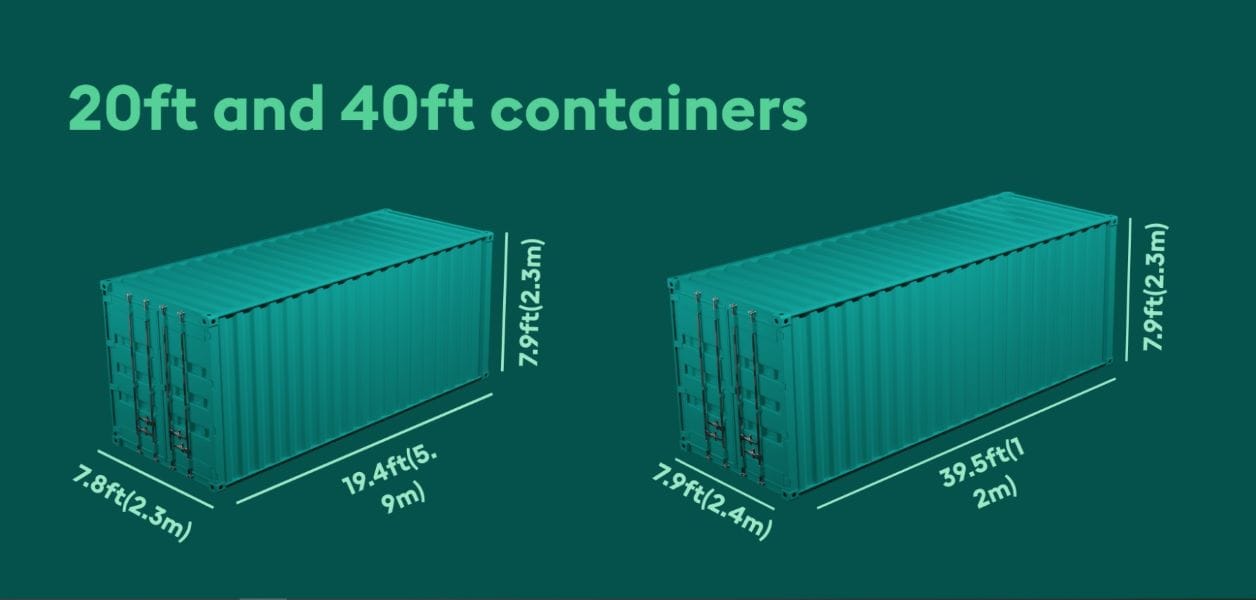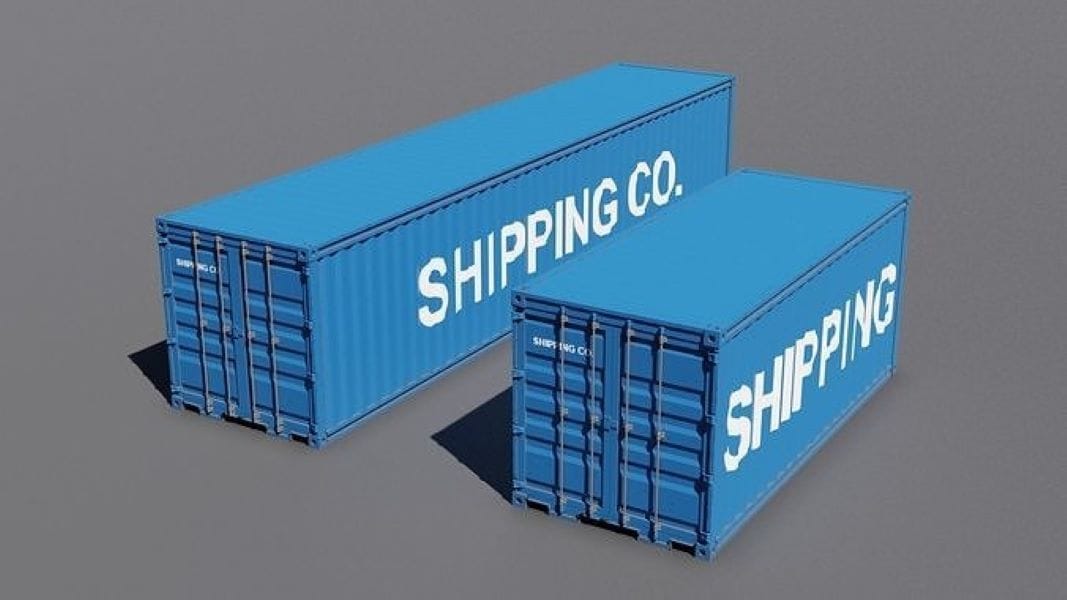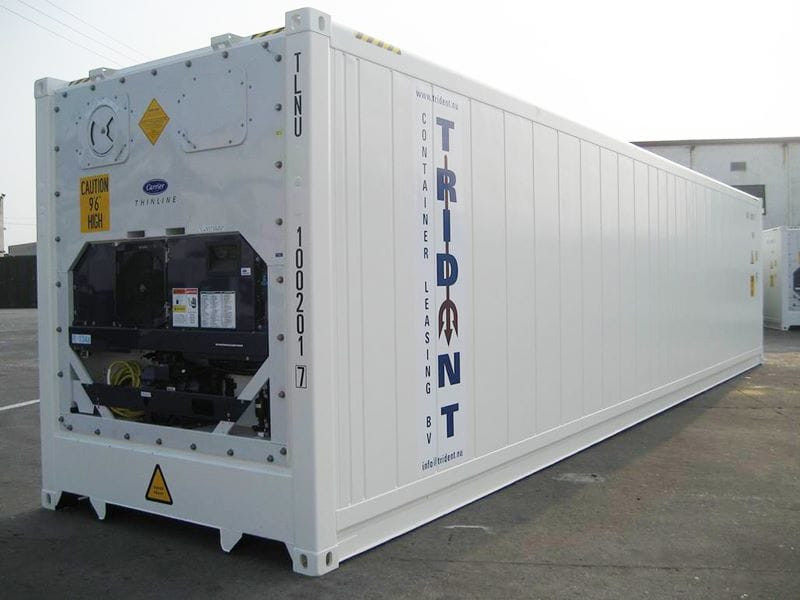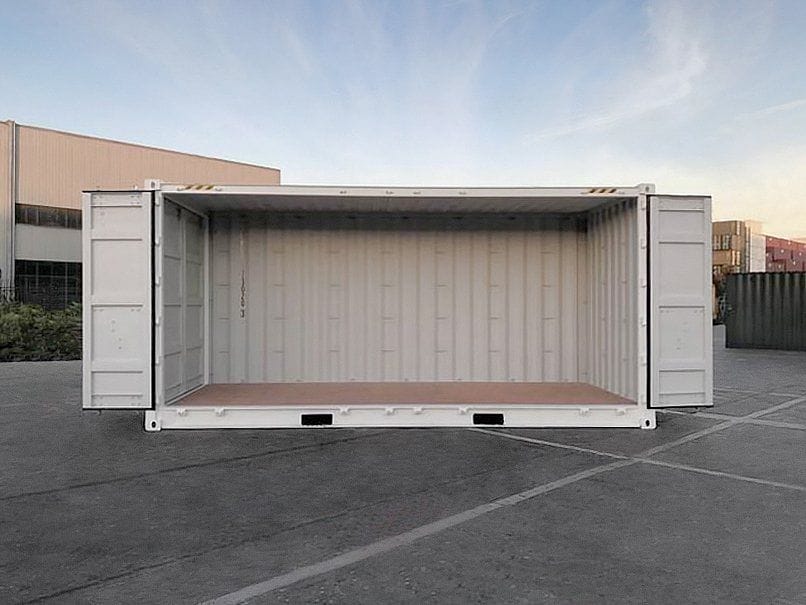With the rapid development of global trade and logistics, containers have become the standard tool for long-distance transportation of goods. According to the needs of different goods, containers have been derived into various types to ensure the safe transportation of goods with different characteristics. This article will introduce various containers in detail
Container Dimensions
The most common standard container sizes are 20 feet and 40 feet. Below I will introduce the specific sizes of both containers

20-foot Standard Container Dimensions
- Interior length:
9.4 feet (5.9 meters) - Interior width:
7.8 feet (2.35 meters) - Interior height:
7.9 feet (2.39 meters) - Tare weight:
4,850 pounds (2,200 kilograms) - Payload capacity:
Approximately 52,000 pounds (24,000 kilograms) - Cubic capacity:
A 20-foot container can accommodate approximately 1,172 cubic feet (33 CBM) of cargo volume.
40-foot Standard Container Dimensions
- Interior length:
39 feet 5.5 inches (12.03 meters) - Interior width:
7 feet 8 inches (2.35 meters) - Interior height:
7 feet 9 inches (2.39 meters) - Tare weight:
8,200 pounds (3,720 kilograms) - Payload:
58,920 pounds (26,760 kilograms) - Volume:
2,389 cubic feet (67.7CBM)
Learn more: How to Choose 20ft and 40ft Containers
Types of Containers
Standard Container
Standard container is the most common type of container, usually 20 feet and 40 feet in size, with high payload, made of steel or aluminum alloy, with waterproof and sealed functions, designed for transporting general cargo. Mainly used for transporting packaged goods, boxed products or dry goods, etc., cannot be sealed liquids or items that need to be refrigerated,

High Cube Container
High Cube Container increases the height of the container to provide more cargo loading space. High Cube Container is usually about 1 foot higher than the standard container, making its interior space more spacious.
Features and Benefits
- Standard Size: Usually there are two common sizes of 40ft and 45ft, and 20ft high cube containers can also be found. The common height is 9.5 feet, providing more cargo loading space.
- More cargo space: Due to the increased height, this container is more economical when loading lighter and larger goods, especially for goods that require large volume but not too heavy (such as home furnishings and textiles).
- Flexibility: Suitable for various types of goods, especially items that require high space, such as furniture, cartons, etc., can help reduce the requirements for loading quantity.
- Applicable scenarios: Commonly used to transport large but light goods, such as furniture, electrical appliances, and mechanical parts

Refrigerated Container
Reefer containers are specially designed for transporting temperature-controlled goods. They can keep the goods fresh by adjusting the temperature. This type of container is suitable for transporting perishable goods such as food, medicine, and flowers.
Features
- Temperature control system: Equipped with advanced refrigeration or heating equipment, the temperature can be adjusted to ensure the quality of the goods during transportation. The temperature range is usually -25°C to +25°C, meeting the needs of different types of goods.
- Reliability: Reefer containers have an efficient refrigeration system that can maintain a stable temperature during long-term transportation to prevent the goods from rotting or deteriorating.
- Multiple uses: Different temperature environments can be adjusted according to the requirements of different commodities. It is suitable for fruits, vegetables, seafood, meat, dairy products, flowers, and medicines that require specific temperature control.
However, reefer containers require additional electricity and refrigeration equipment, resulting in relatively high transportation costs. Regular inspection and maintenance are required to ensure the normal operation of the equipment. The heavy weight reduces the amount of cargo that can be loaded.

Open Top Container
An open top container is a container with an open top, and cargo can be loaded and unloaded from the top. Its design facilitates loading of large items that are irregular in height and cannot be loaded and unloaded through the container door or side.
Features and Advantages
- Open top: The top of this container does not have a closed top structure, but can be protected by a soft top or hard top (removable cover).
- Suitable for large cargo: Especially suitable for transporting large machinery, construction materials, steel, and wood cargo, especially high and wide cargo can be easily loaded and unloaded.
- Flexible loading and unloading methods: Unlike standard containers, open top containers can be loaded and unloaded from the top by crane, which is suitable for scenes that require overhead loading and unloading.

Tank Container
Tank container is a container designed for transporting liquids, gases or chemicals. It is particularly suitable for dangerous goods, chemical liquids, oils and other liquid goods that require strict control.
Features and advantages
- Liquid transportation: Tank containers are designed to transport liquid goods, especially bulk liquids or chemical liquids, such as petroleum, chemical raw materials, and food-grade liquids.
- Safety design: Tank containers are usually designed with anti-leakage and anti-corrosion properties to ensure that there will be no leakage or contamination during transportation. Many tank containers also have heating or cooling systems to ensure the quality of liquids during transportation.
- Suitable for dangerous goods: For some dangerous goods, such as toxic, flammable or highly corrosive liquids, tank containers provide additional safety guarantees and meet international transportation safety standards.
- Environmental requirements: Some tank container designs meet environmental requirements, can prevent pollution, and can be used in closed-loop recycling systems.

Side Open Container
Side Door Container is a container with a side door design. It allows goods to be loaded and unloaded through the side of the container, which is suitable for goods that need to be frequently loaded and unloaded from the side.
Features and Advantages
- Convenient loading and unloading method: Side Door Container is equipped with a side door, so that goods can be quickly loaded and unloaded from the side, especially suitable for storing long, wide, or irregular shaped items.
- Maximize space utilization: Goods can be unloaded from the side of the container more conveniently, and do not need to be squeezed completely through the door like traditional containers, which can reduce loading and unloading time and improve efficiency.
- Applicable scenarios: Especially suitable for carrying large furniture, building materials, mechanical parts and other wide or long goods.

Selection Criteria and Considerations for Containers
Choosing a suitable container requires comprehensive consideration of the following factors to ensure transportation efficiency and cargo safety:
Weight limit
Understand the maximum load of the container to ensure that the cargo does not exceed the container’s load-bearing capacity.
Size limit
Ensure that the size of the cargo matches the internal size of the container to avoid wasting space or being unable to load.
Cargo characteristics
Temperature control requirements (such as food and medicine), liquid transportation requirements (such as chemicals), special shapes or oversized cargo, etc. should choose corresponding refrigerated, tank or open-top containers.
Transportation routes and costs
Depending on the mode and route of transportation, some containers (such as high-box containers) may incur additional costs, and relevant regulations need to be understood in advance. Consider the balance between the cost of the container and the cost of transportation, and choose a cost-effective container.
Loading and unloading convenience
Some goods need to be loaded and unloaded from the side or top. It is recommended to choose a side-opening container or an open-top container for easy loading and unloading operations.
Safety
High-value or fragile goods need to choose containers that meet safety standards to ensure the safety of the goods during transportation.
Durability
Choose a durable container to reduce losses and maintenance costs during transportation.
There are many types of containers, and different containers are suitable for transporting different types of goods. Through this article, understanding the characteristics of various containers and their applicable scope can help companies and individuals plan appropriate options to ensure smooth delivery of goods.
